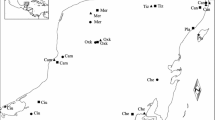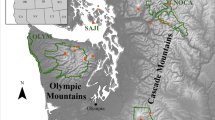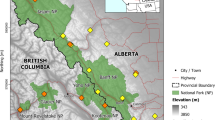Abstract
Oligolectic bees are specialists that collect pollen from one or a few closely related species of plants, while polylectic bees are generalists that collect pollen from both related and unrelated species of plants. Because of their more restricted range of floral hosts, it is expected that specialists persist in more isolated populations than do generalists. We present data on the population structure of two closely related bee species sampled from a super abundant floral host in the southern Atacama Desert. Pairwise comparisons of population subdivision over identical distances revealed that the specialist bee had significantly more differentiated populations in comparison to the generalist. Further, populations of the specialist had significantly less genetic variation, measured as observed and expected heterozgyosity, than those of the generalist. Our data support the hypothesis of decreased gene flow among populations of the specialist bee even at equivalent geographic distances. The resulting reductions in effective population size for specialists make them particularly prone to extinction due to both demographic and genetic reasons. Our findings have important implications for the conservation of bees and other specialist insects.
Similar content being viewed by others
References
Allen-Wardell G, Bernhardt P, Bitner R, Burquez A, Buchmann SL, Cane JH, Cox PA, Dalton V, Feinsinger P, Ingram M, Inouye DW, Jones CE, Kennedy K, Kevan PG, Koopowitz H, Medellin R, Medellin-Morales S, Nabhan GP (1998) The potential consequences of pollinator declines on the conservation of biodiversity and stability of food crop yields. Conserv. Biol. 12: 8–17
Barton NH, Charlesworth B (1984) Genetic revolutions, founder effects, and speciation. Annu. Rev. Ecol. Syst. 15: 133–164
Bohonak AJ (2002) IBD (Isolation By Distance): A program for analyses of isolation by distance. J. Hered. 93: 154–155
Bond WJ (1994) Do mutualisms matter? Assessing the impact of pollinator and dispersal disruption on plant extinction. Philos. Trans. R. Soc. Lond. Ser. B 344: 83–90
Cane JH (2001) Habitat fragmentation and native bees: A premature verdict? Conserv. Ecol., 5, 3 [online] URL: http://www.consecol.org/vol5/iss1/art3/index.html
Cane JH, Sipes SD (2006) Characterizing floral specialization by bees: Analytical methods and a revised lexicon for oligolecty. In: Specialization and Generalization in Plant–Pollinator Interactions (eds. Waser NM, Ollerton J), In press. University of Chicago Press, Chicago, USA.
Carpenter JM (1992) Comparing methods. Cladistics, 8 191–196
Cook JM, Crozier RH (1995) Sex determination and population biology of the Hymenoptera. Trends Ecol. Evol. 10: 281–286
Danforth BN, Ji S, Ballard LJ (2003) Gene flow and population structure in an oligolectic desert bee, Macrotera (Macroteropsis) portalis (Hymenoptera: Andrenidae). J. Kans. Entomol. Soc. 76: 221–235
Dobler S, Farrell BD (1999) Host use evolution in Chrysochus milkweed beetles: Evidence frm behaviour, population genetics and phylogeny. Mol. Eco.l 8: 1297–1307
Felsenstein J (1985) Phylogenies and the comparative method. Am. Nat. 125: 1–15
Fisher RA (1930) The Genetic Theory of Natural Selection. New York: Dover
Frankham R (1995) Conservation genetics. Annu. Rev. Genet. 29: 305–327
Frankham R, Ballou JD, Briscoe DA (2002) Introduction to Conservation Genetics. Cambridge: Cambridge University Press
Futuyma DJ, Moreno G (1988) The evolution of ecological specialization. Annu Rev. Ecol. Syst. 19: 207–233
Goudet J (1995) FSTAT, version 1.2; a computer program to calculate F statistics. J. Hered. 86: 485–486
Goulson D, Hanley ME, Darvill B, Ellis JS, Knight ME (2005) Causes of rarity in bumblebees. Biol. Conserv. 122: 1–8
Hedrick PW, Gilpin ME (1997). Genetic effective size of a metapopulation. In: Hanski IA, Gilpin ME (eds). Metapopulation Biology: Ecology, Genetics, and Evolution. Academic Press Inc., San Diego USA, pp. 165–181
Howard DJ (1993) Small populations, inbreeding, and speciation. In: Thornhill NW (ed). The Natural History of Inbreeding and Outbreeding: Theoretical and Empirical Perspectives. The University of Chicago Press, Chicago USA, pp. 118–142
Kearns CA, Inouye DW, Waser NM (1998) Endangered mutualisms: The conservation of plant–pollinator interactions. Annu. Rev. Ecol. Syst. 29: 83–112
Kelley ST, Farrell BD, Mitton JB (2000) Effect of specialization on genetic differentiation in sister species of bark beetles. Heredity 84: 218–227
Kevan PG, Viana BF (2004) The global decline of pollination services. Biodiversity 4: 3–8
Kimura M (1983) The Neutral Theory of Molecular Evolution. Cambridge, UK: Cambridge University Press
Kimura M, Crow JF (1964) The number of alleles that can be maintained in a finite population. Genetics, 49, 725–738
Koh LP, Dunn RR, Sodhi NS, Colwell RK, Proctor HC, Smith VS (2004) Species co-extinctions and the biodiversity crisis. Science 305: 1632–1634
Kotiaho JS, Kaitala V, Komonen A, Päivinen J (2005) Predicting the risk of extinction from ecological characteristics. Proc. Natl. Acad. Sci. USA 102: 1963–1967
Labandeira CC, Johnson KR, Wilf P (2002) Impact of the terminal Cretaceous event on plant–insect associations. Proc. Natl. Acad. Sci. USA 99: 2061–2066
Lajeunesse MJ, Forbes MR (2003) Variable reporting and quantitative reviews: a comparison of three meta-analytical techniques. Ecol. Lett., 6, 448–454
Linsley EG (1958) The ecology of solitary bees. Hilgardia 27: 543–599
Loxdale HD, Lushai G (1999) Slaves of the environment: The movement of herbivorous insects in relation to their ecology and genotype. Philos. Trans. R. Soc. Lond. Ser. B 354: 1479–1495
Michener CD (2000) The bees of the world. Baltimore, Maryland: The Johns Hopkins University Press
Minckley RL, Roulston TH (2006) Incidental mutualisms and pollen specialization among bees. In: Specialization and Generalization in Plant-Pollinator Interactions (eds. Waser NM, Ollerton J), pp. 69–98. The University of Chicago Press, Chicago, USA.
Nei M (1978) Estimation of average heterozygosity and genetic distance from a small number of individuals. Genetics 89: 583–590
Neigel JE (2002) Is Fst obsolete? Conserv. Genet. 3: 167–173
Packer L, Owen R (2001) Population genetic aspects of pollinator decline. Conserv. Ecol., 5, 4 [online] URL: http://www.consecol.org/vol5/iss1/art4
Packer L, Zayed A, Grixti JC, Ruz L, Owen RE, Vivallo F, Toro H (2005) Conservation genetics of potentially endangered mutualisms: Reduced levels of genetic variation in specialist versus generalist bees. Conserv. Biol. 19: 195–202
Peterson MA, Denno RF (1998) The influence of dispersal and diet breadth on patterns of genetic isolation by distance in phytophagous insects. Am. Nat. 152: 428–446
Rodriguez-Trelles F, Tarrio R, Ayala FJ (2001) Erratic overdispersion of three molecular clocks: GPDH, SOD, and XDH. Proc. Natl. Acad. Sci. USA 98: 11405–11410
Roubik DW (1989) Ecology And Natural History Of Tropical Bees. Cambridge: Cambridge University Press
Rousset F (1997) Genetic differentiation and estimation of gene flow from F-statistics under isolation by distance. Genetics 145: 1219–1228
Saccheri I, Kuussaari M, Kankare M, Vikman P, Fortelius W, Hanski I (1998) Inbreeding and extinction in a butterfly metapopulation. Nature 392: 491–494
Sipes SD, Wolf PG (2001) Phylogenetic relationships within Diadasia, a group of specialist bees. Mol. Phylo. Evol. 19: 144–156
Teillier S, Zepeda H, García P (1998) Flores del Desierto de Chile. Valdivia, Chile: Marisa Cuneo Ediciones
Wcislo WT, Cane JH (1996) Floral resource utilization by solitary bees (Hymenoptera: Apoidea) and exploitation of their stored foods by natural enemies. Annu. Rev. Entomol. 41: 257–286
Weir BS, Cockerham CC (1984) Estimating F-statistics for the analysis of population structure. Evolution 38: 1358–1370
Whitlock MC, Barton NH (1997) The effective size of a subdivided population. Genetics 146: 427–441
Whitlock MC, McCauley DE (1999) Indirect measures of gene flow and migration: Fst does not equal 1/(4Nm+1). Heredity 82: 117–125
Williams P (2005) Does specialization explain rarity and decline among British bumblebees? A response to Goulson et al. Biol. Conserv. 122: 33–43
Wright S (1951) The genetical structure of populations. Ann. Eugen. 15: 323–354
Yeh FC, Boyle TJB (1997) Population genetic analysis of co-dominant and dominant markers and quantitative traits. Belg. J. Bot. 129: 157
Zar JH (1999) Biostatistical Analysis. Upper Saddle River, New Jersey: Prentice-Hall, Inc
Zayed A (2004) Effective population size in Hymenoptera with complimentary sex determination. Heredity 93: 627–630
Zayed A, Packer L (2001) High levels of diploid male production in a primitively eusocial bee (Hymenoptera: Halictidae). Heredity, 87: 631–636
Zayed A, Packer L (2005) Complementary sex determination substantially increases extinction proneness of haplodiploid populations. Proc. Natl. Acad. Sci. USA, 102, 10742–10746
Zayed A, Roubik DW, Packer L (2004) Use of diploid male frequency data as an indicator of pollinator decline. Proc. Roy. Soc. Lond. Ser. B (Suppl.) 271: S9–S12
Acknowledgements
This research was funded primarily by a National Geographic Research and Exploration Grant awarded to LP, REO, HT and LR. We are extremely grateful for the opportunities that this funding provided. Additional support for this research was obtained from the Natural Sciences and Engineering Research Council of Canada through research and discovery grants awarded to LP and through graduate scholarships to AZ and JCG. We are most grateful to Horacio Larraín, Marta Peña, and especially Alfredo Ugarte Peña who was of considerable assistance in planning and facilitating the fieldwork. We thank Asghar Porsa and Leah Gibbens for assistance with running the gels, and Dr. R.L. Minckley and Dr. J.H. Cane for providing us with their manuscripts. We thank two anonymous reviewers for providing helpful comments on the manuscript.
Author information
Authors and Affiliations
Corresponding author
Additional information
Deceased
Rights and permissions
About this article
Cite this article
Zayed, A., Packer, L., Grixti, J.C. et al. Increased genetic differentiation in a specialist versus a generalist bee: implications for conservation. Conserv Genet 6, 1017–1026 (2005). https://doi.org/10.1007/s10592-005-9094-5
Received:
Accepted:
Published:
Issue Date:
DOI: https://doi.org/10.1007/s10592-005-9094-5




